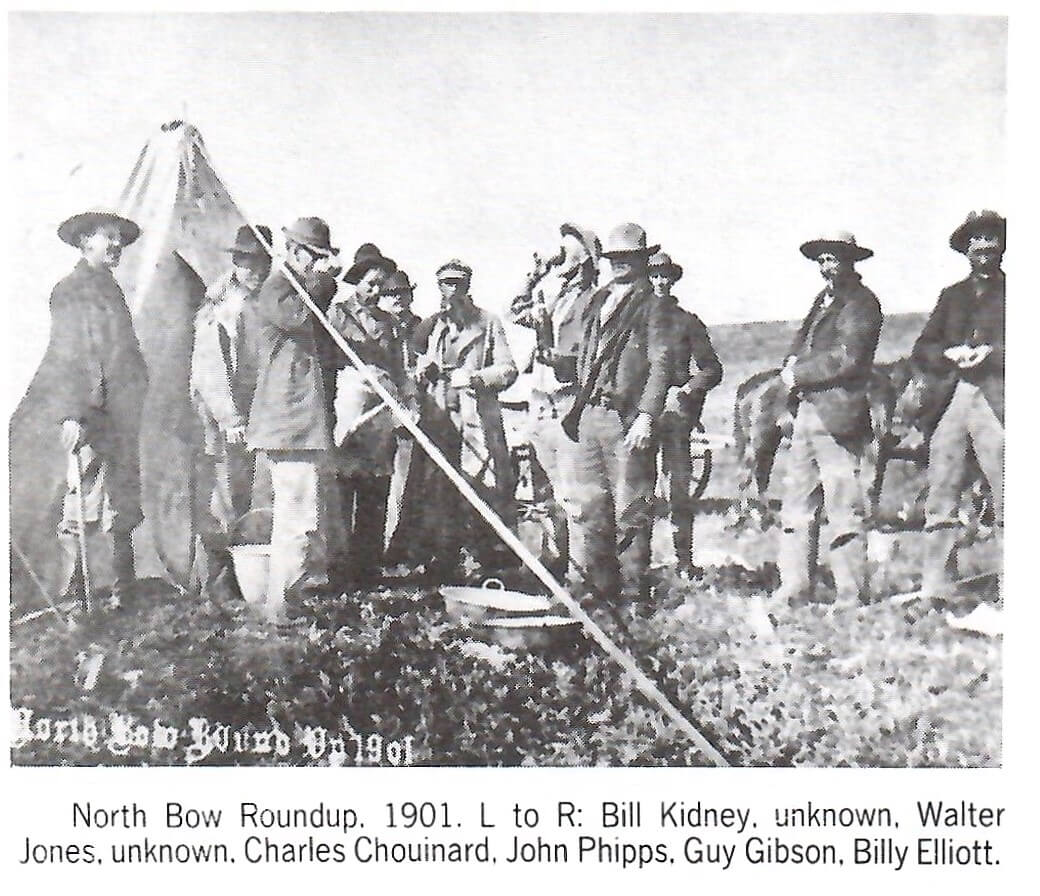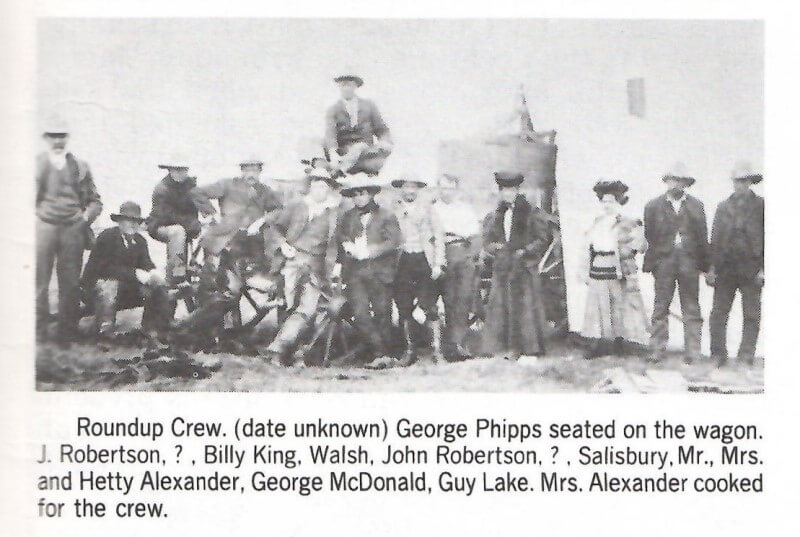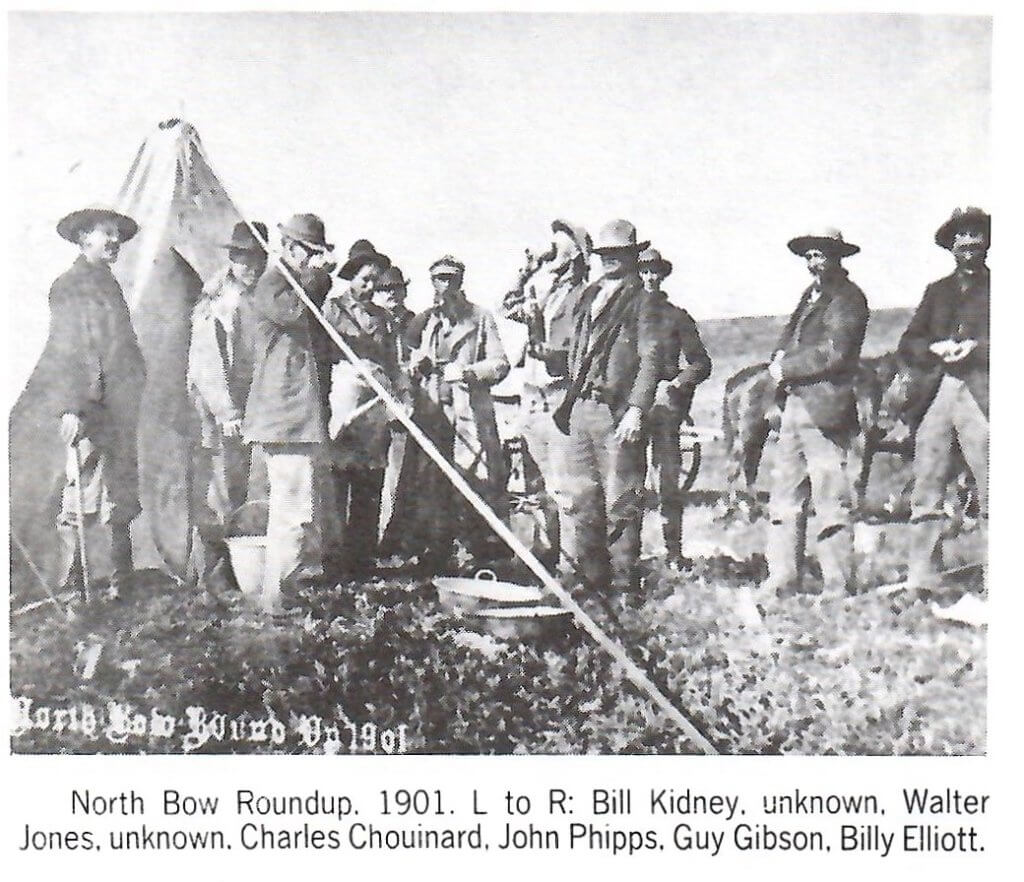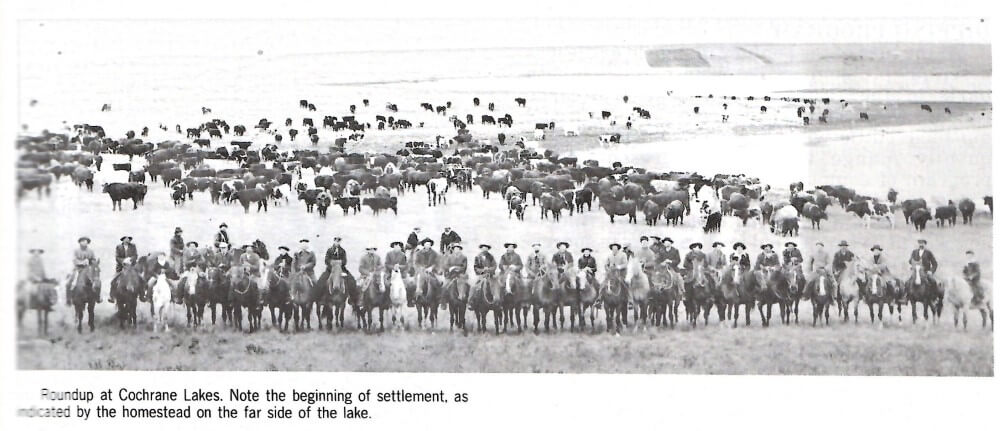This article from page 33 of Big Hill Country really paints a picture of the area in the late 1800’s, early 1900’s.
THE NORTH BOW ROUNDUPS
Before the Cochrane area was settled by homesteaders, a number of ranchers owned large herds of horses and cattle. These herds grazed over the unfenced land from the Morley Indian Reserve to Calgary, and generally, mingled together. Early Mounted Police records indicate that Cochrane ranchers’ cattle ranged from the Bow River to the Little Red Deer River, and east to Nose Creek, although they often drifted farther afield in storms, or in search of fresh pasture. According to information in early brand books, some of the ranchers had ranges, but their unfenced boundaries were vaguely defined. For example, an 1896 edition of Henderson’s Brand Booklists E. H. Botterell’s range as the Westbrook Ranch and Dog Pound Creek; Barney Madden’s range was Beaver Dam Creek. The 1903 Brand Book lists the following: A. J. McDonald’s range was north of the Bow River; R. W. Cowan’s, Big Hill Creek; Mount Royal Ranch, north of Cochrane; A. C. Sparrow’s, both sides of the Bow River; Geo. M. McDougall’s, north and south of the Bow, and the Calgary Cattle Co.’s, northwest of Calgary. Only some of the ranchers’ ranges were listed, but it is obvious that cattle or horses could be “at home on the range” almost anywhere.
No information or photographs are available about any roundups of horses in the Cochrane area; herds were generally small enough that they were, presumably, kept closer to the home ranch.
The intermingling of various herds meant that the cattle had to be gathered occasionally and sorted. Roundups were usually held in the fall. The owners sorted their cows and calves so that the calves could be branded and weaned. Steers were also cut out for fattening or immediate sale; any mavericks were cut out and trailed to market. Proceeds from their sale were generally divided among those ranchers having cattle in the bunch that was rounded up.
After mange became prevalent, dipping was made compulsory in 1904, and roundups were held for that purpose.
In 1890 a census of livestock in Southern Alberta was taken by the Mounted Police. Figures were compiled from ranchers’ estimates, the judgements of N.W.M.P. patrol constables and roundup figures. Livestock numbers listed were very approximate; estimates of the big ranchers would be low, while small ranchers would tend to exaggerate a bit. The report lists the following Cochrane district ranchers and the number of animals they owned:
| NAME | HORSES | CATTLE |
|---|---|---|
| J. Robertson | 300 | 600 |
| Bow River Horse Ranch | 500 | -- |
| D. McDougall | 275 | 500 |
| J. McDougall | 73 | 200 |
| Leeson and Scott | -- | 615 |
| Mount Royal Ranch | -- | 600 |
| W. D. Kerfoot | 53 | 500 |
| W. Bell-Irving | 91 | 150 |
| J. McKinnell | -- | 240 |
| Brealy Bros. | -- | 220 |
| Shea and Madden | -- | 200 |
| R.W. Cowan | -- | 200 |
| Sibbald Bros. | 50 | 200 |
The biggest roundup in Alberta’s history took place in May 1884, near Fort Macleod. One hundred men took part, using a remuda of five hundred horses. Fifteen mess wagons provided food for the men. About sixty thousand cattle were rounded up. Picture the vastness of the herd, the noise, and the dust! Picture, too, the problems involved in feeding, watering, holding and sorting such a large number of cattle. The ranchers involved decided that such a general roundup was too cumbersome, and from then on smaller ones were held.
No information is available as to the size of roundups in the Cochrane area but judging from photographs, several thousand cattle were gathered. The gathering area was at Cochrane Lakes; abundant water and grass were available there, and the fairly level land north and east of the lakes also made it a suitable place.
When one speeds along the Dog Pound road, officially known as Highway 22, it is difficult to visualize the country as it looked in 1900 or before. The largest of the three Cochrane Lakes can be seen west of the road. Roundup camps were generally situated on the east side of the lakes. The cattle were held east and north of the lakes, possibly because of the heights of land to the south and west.
According to photographs, which unfortunately are not dated, about twenty men usually took part in the Cochrane Lakes roundup. There is no definite information as to when the last roundup took place. It can be assumed that settlement, which meant the end of the open range, and the severe winter of 1906-07, during which hundreds of cattle perished, ended the practice in about 1907.
Other roundups held in Big Hill Country included those on the Beaver Dam Creek (gathering place unknown), and at Rocky Butte, on Section 24-26-2-5, north of Jim Stevenson’s present home. According to reports, the last roundup at Rocky Butte was held about 1910, and twenty thousand cattle were gathered.
Laurie Johnson recalls:
“In the fall of 1910, there was a cattle roundup at Rocky Butte. It covered the territory from Nose Creek to the Bow River and west to Cochrane Lakes. There was a shack for the cookhouse, where a man named Charlie did the cooking, and there was a tent for the riders. One or two of the ranchers who lived nearby went home at night. As the cattle were gathered, they were held in fields that had been fenced.
“The following ranchers took part in the roundup: James Robertson of Crossfield, D. P. McDonald of Mount Royal Ranch, George McDonald of Rocky Butte, Ernie Archibald, Gustave Delbeke, Johnny Robinson of Big Springs Ranch, Fred Newsome of the Burnt Ground, Angus McDonald of Beaver Dam, and myself. I was working for Angus McDonald and was fourteen years old at that time. I am the only one of these men alive today.”
As Big Hill Country becomes more heavily populated, fences crisscross even the quarter sections, and pasture fields steadily shrink. It becomes harder to visualize our country as it was when cowboys gathered the free-ranging cattle for the roundup. The words of the song, Don’t Fence Me In, are a lament for the “good old days.”










